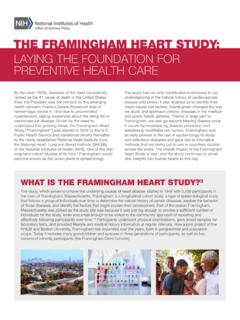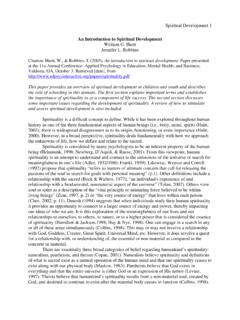Transcription of About Behavioral and Social Sciences Research
1 1 About Behavioral and Social Sciences ResearchThe 21st century is an exciting time a revolutionary period for the life Sciences . We have learned a lot About the biological parts and systems that make up all living things. We also realize that it is just as important to understand how behavior and society affect health and can help fight disease. Combining information from both biomedical and Behavioral and Social Sciences Research will lead to the most effective is Behavioral and Social Sciences Research ?
2 Behavioral is a term that covers a lot of ground. It refers to what people do, as well as what drives them to do things, and it involves psychological processes like emotion. Social , on the other hand, reflects how individuals interact with each other: in small groups, families, and communities, as well as within populations and in and Social Sciences Research helps predict, prevent, and manage illness in individuals and in whole populations. This Research also helps people change their behaviors, understand treatments, and learn how to stick with them.
3 Society s role is significant, too: access to health care affects decision making and Heart Truth campaign educates women About heart disease. In March 2009, 69 percent of women were aware that heart disease is the leading cause of death among women, up from 34 percent in Back to Sleep health awareness campaign that promotes infant back-sleeping cut the incidence of sudden infant death syndrome, or SIDS, by more than 50 percent in a 12-year Works?In recent years, NIH-funded Behavioral and Social Sciences Research has led to important wins in the battle against many diseases and conditions that strike Americans throughout life.
4 For example, scientists have learned that:.. child-specific household interventions such as mattress covers, air filters, and professional pest control reduce unscheduled clinic visits and medication use in inner-city children with adults can delay or prevent type 2 diabetes through modest lifestyle changes losing a small amount of weight, eating a healthy diet, and being physically active a total of two and a half hours per week.. increasing condom use, limiting sex partners and delaying sex, increasing acceptance of male circumcision in certain cultures, and increasing access to substance abuse treatment programs reduces the spread of Behavioral therapies help engage people in treatment for drug abuse, modify drug-use attitudes and behaviors.
5 And improve life skills to promote people who have recently attempted suicide were 50 percent less likely to try to kill themselves again within 18 months when they were treated with a certain type of a mix of Behavioral , economic, Social , and public policy interventions has contributed to a dramatic decline in smoking among American men: 25 percent now smoke compared to About 50 percent in the mid-1960s.. even moderate exercise and physical activity can help improve and maintain physical strength and fitness, as well as manage and prevent some diseases that accompany Social media like text messaging, Learn the Link educates young adults About risky behaviors linked to drug abuse, in particular the connection to Can!
6 Behavioral educational programs for children ages 8 to 13 and their families encourage healthy eating, increased physical activity, and reduced screen s the Need?Unhealthy behaviors like smoking, excessive alcohol consumption, and drug abuse as well as inactivity and poor diet raise the risk for many debilitating and costly health problems. Collectively, these behaviors contribute to approximately 40 percent of all deaths in the United States. Behavioral and Social Sciences Research has never been more timely and important, and the NIH sees great opportunities to apply what we have learned toward helping change people s behaviors to improve their health and one-third of all adults and nearly one-fifth of the nation s children are obese, raising risk for a variety of health conditions including heart disease, type 2 diabetes, sleep disorders, some cancers.
7 And annual economic costs of illicit drug use in the United States are About $181 billion. Yet, as staggering as this number is, it does not reflect the devastating consequences of drug abuse and addiction on individuals, families, communities, and society as a than 20 million people worldwide have died from AIDS-related illnesses, and unsafe sex and substance abuse are major contributing DiseasePromoting lifestyle and Behavioral changes increasing physical activity, quitting smoking, and lowering cholesterol and salt could save thousands of Americans from their number-one killer: heart AbuseAlcohol is a factor in About 50 percent of drownings and homicides, 40 percent of burns and motor vehicle crashes, 30 percent of suicides, and half of all sexual assaults.
8 Mental IllnessMajor mental disorders like depression and anxiety affect About one in four American adults in a given year and are the leading cause of disability among people ages 15 to 44 in the United States and Canada. The Rethinking Drinking program gives individuals user-friendly, interactive, anonymous tools to measure and modify behaviors related to alcohol Do Scientists Study Behavior and Society? Behavioral and Social Sciences researchers use a range of methods. Understanding how and why individuals behave and how they interact with each other and their environment relies on many different approaches and types of DataStudying people where they are, in real life, is key.
9 Using a method called ecological momentary assessment, or EMA, scientists collect real-time or near-real time data during the course of a participant s daily life. This technique is valuable because it doesn t rely on people remembering what they did and helps control for accuracy in Participatory ResearchLanguage and cultural barriers often block effective prevention messages from reaching people at risk. By partnering with community members, researchers are better informed About community needs and can learn the best ways to tailor the delivery of information and Models Scientists use a range of animal models to learn About human behavior.
10 Fundamental studies in honeybees, fish, and hamsters have taught us About Social behavior, for instance, and genetic Research with fruit flies has helped explain circadian rhythms and why people need sleep. Sociocultural Approaches Effective prevention and treatment of HIV/AIDS, hepatitis, and sexually transmitted diseases is enhanced by evidence-based understanding of various Behavioral , Social , and cultural factors including stigma and what motivates behavior change. Genome Scans Identifying reliable risk factors is a key component of effective prevention.














